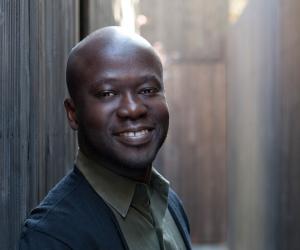From the Series
Most documentaries about architecture show you the building from the architect’s point of view: they talk about their vision and how they chose to interpret the brief in terms of materials, layout, footprint and formal qualities.
But Oliver Hardt’s documentary, David Adjaye – Collaborations, relies predominantly on interviews with Adjaye’s clients whom he sees as collaborators. It was commissioned by the Haus der Kunst in Munich and The Art Institute of Chicago as part of the exhibition David Adjaye: Form, Heft, Material, curated by Okwui Enwezor and Zoë Ryan.
The result of keeping the architect largely absent – as seen in this excerpt featuring the studio of Brooklyn artist Lorna Simpson – is that the audience can really appreciate how the built structure takes on a life that both mirrors and shapes the people who inhabit it.
Like her own art, which encompasses photography, video, drawing and collage, the studio that Simpson shares with her partner, James Casabere, is an adaptable space.
The four-story building is built on the site of a former carriage house in the historic neighbourhood of Fort Greene, Brooklyn. The first American project by the London-based architect, it shares an unusual feature with some of his other residential projects – its exterior appears impenetrable from the street.
“David’s buildings have a kind of presence, wherever they are,” Simpson observes. “They are always cloaked. They don’t give a narrative of what this is.” She explains that passersby on the street frequently reach out to touch the building’s exterior in order to understand what it is made of.
In the case of Vanderbilt Studio, as the Brooklyn property is known, it is made of polypropelene panels normally used for shipping containers. In the case of British artists Sue Webster and Tim Noble’s home/studio in Shoreditch, London (also featured in the documentary), Adjaye pressed the couple to paint the exterior a dark matte grey using a coating known for its anti-graffiti properties.
“It would be presumptuous of me to say that this building had anything to do with me personally – in terms of its look and what it is. This is all David,” Simpson says. She works in front of a large window whose “six-by-nine-foot” view onto people’s backyards echoes the format of what she sees when she looks through her photographic lens.
That speaks to the kind of work I do. The conversation that takes place is his observation of me as an artist, she says.
If the architect has a signature style, it is not immediately apparent. “It is [apparent] by how you perceive the exterior and how that belies what goes on in the interior. There’s a compression and expansion of space.”
"David Adjaye – Collaborations" is playing at Design Indaba FilmFest 2015 on Sunday, 22 February at 20:00 at The Labia Theatre. Book tickets here.









